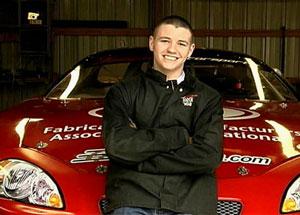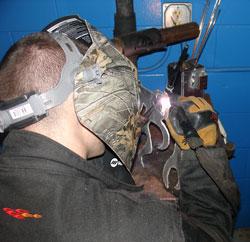- FMA
- The Fabricator
- FABTECH
- Canadian Metalworking
Categories
- Additive Manufacturing
- Aluminum Welding
- Arc Welding
- Assembly and Joining
- Automation and Robotics
- Bending and Forming
- Consumables
- Cutting and Weld Prep
- Electric Vehicles
- En Español
- Finishing
- Hydroforming
- Laser Cutting
- Laser Welding
- Machining
- Manufacturing Software
- Materials Handling
- Metals/Materials
- Oxyfuel Cutting
- Plasma Cutting
- Power Tools
- Punching and Other Holemaking
- Roll Forming
- Safety
- Sawing
- Shearing
- Shop Management
- Testing and Measuring
- Tube and Pipe Fabrication
- Tube and Pipe Production
- Waterjet Cutting
Industry Directory
Webcasts
Podcasts
FAB 40
Advertise
Subscribe
Account Login
Search
Go! Brennan
Putting the pedal to the metal and taking the metal to the classroom
- By Vicki Bell
- February 26, 2008
- Article
- Arc Welding
What moves faster than Brennan Palmiter's stock car? Palmiter himself—a young (16), motivated, bright, articulate, energetic dynamo who lives life to the fullest and wants to help other young people do the same.
Palmiter, a Livingood Motorsports driver from Ormond Beach, Fla., loves to weld and is committed to encouraging young people to consider careers in manufacturing. Joining forces with the Fabricators & Manufacturers Association International (FMA), Palmiter will play a key role in the FMA Foundation scholarship program, which offers scholarships to young people attending trade schools or colleges and universities who are preparing for careers in metal manufacturing.
FMA and its publication Practical Welding Today®are sponsoring Palmiter for the 2008 racing season. FMA's logo will be emblazoned on the hood of his car and appear on his uniform. The Practical Welding Todaylogo will appear on the car's rear bumper.
Background
Palmiter began racing go-karts when he was 7 years old and later raced in the novice class at a local track near his home. From there he branched out to compete at go-kart dirt tracks in Florida, eventually racing in the WKA State and National Dirt Series. From 2001 to 2004, he scored 85 top-five finishes and 17 state and national wins in about 175 starts.
In 2005 Palmiter moved from karting to racing a TQ Late Model stock car. He competed at dirt and asphalt tracks throughout north Florida and south Georgia, scoring 12 top-five finishes and one win in just 30 starts and finishing his first season fourth in overall points.
In 2006 Palmiter raced a Limited Late Model car at New Smyrna Speedway and earned 2006 Late Model Rookie of the Year honors. In 2007 he ran the full season at New Smyrna Speedway, finishing second in points and making his debut with the Goodyear Challenge Series.
Palmiter is enrolled in an accelerated-graduation program at Seabreeze High School in Daytona Beach, Fla., that allows him to graduate in just three years. He also takes night classes in welding technology at Daytona Beach Community College. In May 2009 he will graduate from both high school and junior college with a high school diploma and a vocational certificate in welding technology with four specialized welding certifications.
More About Welding
A young man being interested in racing isn't in the least bit surprising. However, you don't often hear young men or women express an interest in welding. In Palmiter's case, exposure to welding sparked his interest, an interest he hopes to pass on to others.
Palmiter had just begun driving cars on asphalt. He was "used to that loose feeling from a dirt car, and when the car got really loose, I thought I'd try to drive it like my dirt car. So I gunned the throttle, turned right on a left-hand turn, and shortly found out that didn't work. I ended up driving the car straight into the wall, nose first.
"It was incredible; it happened so fast that I didn't have time to let go of the throttle. It was a very bad rookie mistake. The frame was bent all over—bent in ways you could never imagine steel bending by itself. [My dad and I] didn't have the money to buy a new frame. It was up to me to find some way to fix the car.
"I have an old friend, Jeremy Boddie, who knows a lot about welding. He worked at a shop that had a lift and employed several welders. When he got off work, he let us in, and we worked on the car most of the night.
"[Boddie] had a piece of metal that was ready to be welded in place. He asked me if I had ever welded before, and I told him I hadn't, so he welded it in place and I helped here and there. But after the car was finished, I got to play around with the welding machine! At 10 years old, that was like doing college geometry!
"Buddy Knock, another welder at the shop, decided to give me a short welding lesson. I was really bad at first. Buddy gave me a ton of tips on torch angles and different ways to move the puddle down the metal. It took a lot of practice, but now I think I'm pretty good at it. I've been practicing for about six years now, and I still look at a weld and say, 'I think I can do it better next time.'
"Each lap, I go into the corner faster and drive it harder and hope it sticks, trying to get a better lap time. Then, when I hear the lap time, I always tell my dad I could make it go faster if I change something. It's the same with my welding. No matter how good the weld, I always end up saying, 'I could have made it look a little bit better if I had done this or that.'"
Developing Skills
Palmiter followed similar paths to develop his driving and welding skills—"a ton of practice." Commenting on perfecting his welding skills, he said, "I had this vision of what a good weld should look like, so when I started to practice, I aimed for that vision. It took me a while to get it. It was a lot of fun just to sit and play with different torch angles to get a good bead laid down. Playing with different torch angles, speeds, temperatures, and wire speed taught me what different options do and how they affect my workpiece."
Palmiter's welding is not reserved for his race car. He currently is building a pit wagon and also is planning to open an aluminum trailer cabinet company when he becomes more proficient at welding aluminum.
Racing Versus Welding
When asked which is more difficult, welding or stock car driving, Palmiter said they are about the same. "Driving a race car is pretty hard to do, if you want to win. Welding, I figure, is about the same. If you want to make really beautiful welds, it can be pretty difficult."
Which is more dangerous? Palmiter noted that without the right safety devices, anything can be dangerous. He said, "Welding can be more dangerous than driving a race car, because it's easy to forget to use all your safety equipment and accidentally harm yourself. In racing, you spend almost all the time preparing and only a short amount of time actually racing. Still, a couple of years ago, Dale [Earnhardt] Jr. hit a wall and the car caught on fire. He had some nasty burns on his legs, because he didn't use fireproof underwear. It was just a practice event, so he wasn't as prepared as he should have been.
"Safety is extremely important. It can cost a lot of money, but it also can stop a lot of pain or even death. Being a young welder and racer, I always want to be safe. I love welding and I love racing, but if I get a little sloppy on my safety, I could be injured in a way that I wouldn't be able to do the two things I love. That's exactly why I use some of the latest safety devices available."
Spreading the Word
Palmiter encourages other students to at least try welding. "It's a great-paying career; it's not that hard [to learn the basics], and there is such a high demand for welders, it's easy to find a good job, no matter where you live."
His affiliation with FMA will enable Palmiter to share his love of racing and welding with many more young people. He is teaming up with Practical Welding Todayfor a contest in which students will compete for Palmiter and his car to appear at their schools to talk about racing and welding. He also is involved in a YouTube video competition in which participants will compete for FMA Foundation scholarships in Brennan's name.
About the Author

Vicki Bell
2135 Point Blvd
Elgin, IL 60123
815-227-8209
About the Publication
subscribe now

The Welder, formerly known as Practical Welding Today, is a showcase of the real people who make the products we use and work with every day. This magazine has served the welding community in North America well for more than 20 years.
start your free subscription- Stay connected from anywhere

Easily access valuable industry resources now with full access to the digital edition of The Fabricator.

Easily access valuable industry resources now with full access to the digital edition of The Welder.

Easily access valuable industry resources now with full access to the digital edition of The Tube and Pipe Journal.
- Podcasting
- Podcast:
- The Fabricator Podcast
- Published:
- 04/16/2024
- Running Time:
- 63:29
In this episode of The Fabricator Podcast, Caleb Chamberlain, co-founder and CEO of OSH Cut, discusses his company’s...
- Industry Events
16th Annual Safety Conference
- April 30 - May 1, 2024
- Elgin,
Pipe and Tube Conference
- May 21 - 22, 2024
- Omaha, NE
World-Class Roll Forming Workshop
- June 5 - 6, 2024
- Louisville, KY
Advanced Laser Application Workshop
- June 25 - 27, 2024
- Novi, MI

































